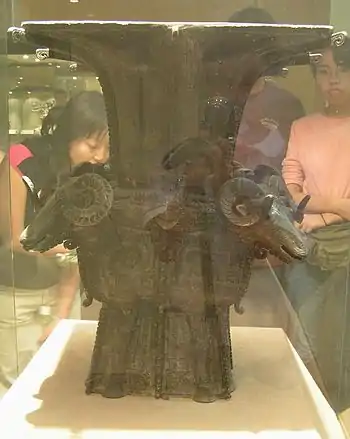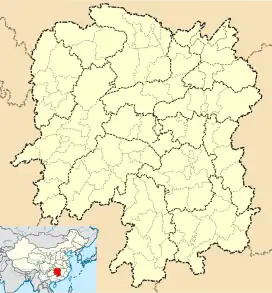炭河里 | |
 Tanheli Site | |
 Location within Hunan | |
| Region | Huangcai, Ningxiang, Hunan |
|---|---|
| Coordinates | 28°09′09″N 112°06′46″E / 28.15256418933271°N 112.11280976686477°E |
Tanheli (Chinese: 炭河里; pinyin: Tànhélǐ) is an archaeological site in Ningxiang, Hunan, one of major national historical and cultural sites in Hunan.[1][2]
Situated in the upper reaches of the Wei River in Tanheli village, Huangcai town, Ningxiang, it is renowned as a Bronze Age cultural center in South China.[1][3] Tanheli is famous as the location where the Four-goat Square Zun and the Da He ding were excavated along with 300 other bronze relics.[1][4] It was identified as a site of the Western Zhou dynasty (ca. 11th century–771 BC). The core covers an area of 888,600 square metres (9,565,000 sq ft).[5]
References
- 1 2 3 Wang Xijia (2014), p. 16–17.
- ↑ changsha.gov (September 16, 2016): Tanheli Bronze Museum to be open on September 30
- ↑ nxagri.gov (July 3, 2015): About Tanheli Site (Chinese / 中文)
- ↑ prnewswire.co.uk: Ningxiang's Annual Tourism Conference Invites Guests Worldwide to Visit
- ↑ nxagri.gov: About Tanheli Site (July 3, 2015)
Bibliography
- Wang Xijia (2014). 长沙史话 [A Brief History of Changsha] (in Chinese). Beijing: Social Sciences Academic Press. ISBN 978-7-5097-6662-0.
This article is issued from Wikipedia. The text is licensed under Creative Commons - Attribution - Sharealike. Additional terms may apply for the media files.